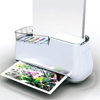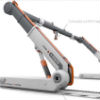[ By Delana in Conceptual & Futuristic & Technology. ]

Printers have become much more complex than simply machines that spit out pieces of paper with ink on them. Designers are envisioning all kinds of futuristic printers that will give us information on demand, 3D printed objects, food and even body parts. These 10 concepts and actual products are on the very cutting edge of printer technology.
The Filabot

The Filabot, an invention from Vermont Technical College student Tyler McNaney, is reinventing the way 3D printing works. It is, in essence, a printer of the materials used for 3D printing. Confused yet? The Filabot takes waste plastics, grinds and melts them down, then extrudes the plastic into filament. The filament is the “ink” for 3D printers which is laid down layer by layer until the desired object is created.
The Oksu

The Oksu, from designer Alex Zhulin, was created to share digital links in a physical format. When you find something you love – a YouTube video, for example – the Oksu prints out a speech bubble-shaped piece of paper with an image and description of the digital content. The paper also contains a near-field communication (NFC) chip which allows it to communicate with mobile gadgets, calling up the link on the screen. It’s kind of like sending a link via email, only there is a physical layer to the act. After the link has been visited, the little paper can still be used as a reminder of the interaction – which is much more fun than just saving an email.
The PrintBrush

Having a printer available is so commonplace that most of us rarely think about the functionality of these machines. Swedish engineer Alex Breton thought about it, and he didn’t see any reason we have to be tethered to traditional printers with their very limited paper sizes. He invented the PrintBrush, a hand-held printer that can go anywhere and print onto anything. You simply hold the device and pass it over the surface you want to print on – the PrintBrush detects its position and the rate at which you’re moving it, ensuring that each pixel is perfectly placed.
Skin Cell-Printing Inkjet

When skin is damaged beyond repair by burns or other wounds, a skin graft is usually the go-to treatment. But there are many complications inherent in skin grafts, including scarring and the possibility of rejection or infection. This device, created at Wake Forest University in South Carolina, would greatly reduce any risks by doing away with skin grafts entirely. Instead, the device “prints” – or, maybe more accurately, sprays – healthy skin cells directly onto a wound, where they can grow into a normal part of the patient’s skin. With this new method, there is no scarring, no risk of the body rejecting the new skin, and the repaired areas even grow their own hair. Perhaps best of all, the bio-printer drastically reduces wound healing time.
Toilet Roll Twitter Printer

There’s no delicate way to put this: people like to read while on the toilet. Some of us choose to take a book or magazine in, but this very unusual printer was designed to take their place. Brought to life by German inventor Mario Lukas for a hardware competition, the device prints your Twitter feed directly onto a roll of toilet paper for reading and subsequent wiping. Using toilet paper printed with Twitter updates might be the ultimate way to show your feelings for the microblogging site and the folks you follow there.
The Circle Printer

Have you ever wondered why home printers are so huge and bulky? There are several reasons for the size and shape of traditional printers, but the Circle Printer from designer Yang Jae Wook turns them on their side. The diminutive printer is just the essential parts needed to print, and these essential parts are housed in an attractive, artsy shell. It sits on its smallest side to take up the least amount of room on a desk or table, but still functions like any other printer. For infrequent home users, the Circle Printer would be equal parts decorative and functional. Alas, for now it is only a concept.
The Aroma Printer

Taking photos of food seems almost like a new national pastime. We snap pictures when we make something, when we’re at a restaurant, or just when we feel that a meal deserves to be documented. The one important component missing from this food photography? Scent. This conceptual printer was designed by student Zhu Jingxuan in a Sony Student Design workshop in order to right that wrong. As the device takes a picture of your meal, it also captures the scent and embeds it in the paper of the little postcard it prints your photo onto. From sharing recipes to enjoying memories of home, this fun concept could have so many real-world uses.
The Hanging Printer

Finding room for a big, bulky office printer can be a daunting task, which is why designer Jaesik Heo stepped up to create the Hanging Printer. The printer hooks over the side of a desk, leaving the bulk of the machine to hang down over the side. The printer would work just like any other, but using a fraction of the desk space.
The Little Printer

It used to be that in order to keep up on local and world events, a newspaper subscription was the best way to do that. Not anymore, however: our computers and smartphones have given us constant access to information. The Little Printer from BERG Cloud is kind of a next-generation newspaper, using your personalized preferences to periodically print out a paper that is just for you, personally. You set the news stories, games and other content you want, then once or twice a day your personalized newspaper is printed from your adorable Little Printer. Between newspaper printings, the printer displays a cute face just to let you know how friendly it is.
Organ Bio-Printer

For people waiting around for organ transplants, the wait is excruciating and, all too often, a compatible donor organ is never found. What if we could actually build new organs from the cellular level? A company called Organovo has developed a 3D printer that does exactly that using patients’ own cells. The risk of transplant rejection will be virtually erased since the new organs are made from the patient’s own biological material. Thanks to the amazing technology behind this printer, the wait time for a new organ would be significantly shortened, potentially saving many lives every year. The printer is only capable of making new arteries at the moment, but within a decade bio-printers will be able to print more complex objects like bones and hearts.






[ By Delana in Conceptual & Futuristic & Technology. ]
[ WebUrbanist | Archives | Galleries | Privacy | TOS ]

WebUrbanist






















You must be logged in to post a comment.